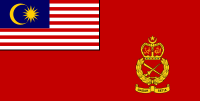Malaysian Army
| Malaysian Army Tentera Darat Malaysia |
|
|---|---|

Crest of the Malaysian Army
|
|
| Active | Since 1 March 1933, but started under Penang rifle volunteers in 1861 |
| Country |
|
| Allegiance |
|
| Branch |
|
| Type | Army |
| Role | Defence and Dominance of Malaysia's soil |
| Size | 80,000 active personnel (2003) 50,000 reserve (2003) |
| Motto(s) | "Gagah Setia" (Strong and Loyal) |
| Colours | Red and Gold |
| Anniversaries | 1 March |
| Engagements |
World War II 1st Malayan Emergency (1948–1960) Communist insurgency in Malaysia (1968–89) Sarawak Communist Insurgency (1962–1990) Indonesia–Malaysia confrontation United Nations Operation in the Congo Battle of Mogadishu Kosovo War United Nations Iran–Iraq Military Observer Group 2006 East Timorese Crisis (OA) MALCON–UNIFIL United Nations Protection Force ISAF Cross border attacks in Sabah (2013 standoff) |
| Website | army |
| Commanders | |
| Commander-in-Chief | Yang di-Pertuan Agong |
| Chief of Army | General Zulkiple Kassim |
| Insignia | |
| Flag |  |
The Malaysian Army (Malay: Tentera Darat Malaysia) is the land component of the Malaysian Armed Forces. Steeped in British Army traditions, the Malaysian Army does not carry the title ‘royal’ (diraja) as do the Royal Malaysian Air Force and the Royal Malaysian Navy. Instead, the title is bestowed on selected army corps and regiments who have been accorded the honour by the Yang di-Pertuan Agong, who is the Supreme Commander of the Malaysian Armed Forces.
The first military units in Malaysia can be traced back to the Penang Rifle Volunteers raised on 1 March 1861, and the Malay States Volunteer Rifles which existed from 1915 to 1936. The birth of the modern Malaysian Army came about when the Federal Council of the Federated Malay States passed the Malay Regiment Bill on 23 January 1933. This allowed the initial recruitment of 25 males for the First Experimental Malay Company on 1 March 1933. Major G. McI. S. Bruce of the Lincolnshire Regiment was the first Commanding Officer. By 1 January 1935, the Experimental Company became The Malay Regiment with a complement of 150 men. A battalion was formed on 1 January 1938 and eventually a second battalion on 1 December 1941. The 1st Bn Malay Regiment was famous for its defence of Opium Hill or Bukit Chandu in Singapore. The ‘Battle of Opium Hill’ on 14 February 1942 involved 42 soldiers commanded by Lt. Adnan Bin Saidi who defended their position against attack from the 18th Division of the Japanese Imperial Army under Lt. Gen. Renya Mutaguchi. After World War II and during the Malayan Emergency, the number of battalions was increased to seven in the early 1950s.
...
Wikipedia
